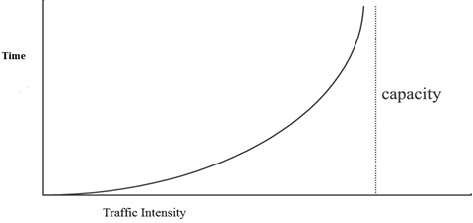Arrival Rates, Service Rates, and Traffic Intensity
The (average) arrival rate is the rate of arrival of customers at a queue, and is often denoted by x.
If 10 customers arrive at a queue each hour: x = 10 and (1/ x) x 60 minutes = every 6 minutes is the inter-arrival time.
The (average) service rate is the rate at which customers could be served, and is often denoted by the letter µ.
If on average, 20 customers could be served every hour, µ = 20 and the average service time would be
1/ µ x 60 minutes = 3 minutes.
The traffic intensity is the ratio or the average arrival rate to the average service rate. It is denoted by P.
Thus P = x/ µ
If the arrival rate is 10 per hour and the average service rate is 20 per hour, the traffic intensity would be:
P = x/ µ = 10/20 = 0.5
If a queuing system is to work x must have a lower value than µ and the traffic intensity P, must be less than one. As x approaches µ in size, the average length of the queue and the average time spent in the system will grow as the service personnel find it increasingly hard to keep up with the demand. This point is illustrated below.

When the traffic intensity is equal to or greater than 1, the average time spent by each customer in the system would theoretically be infinite.